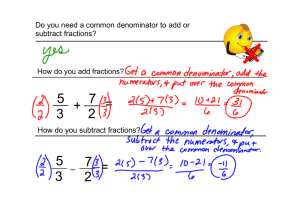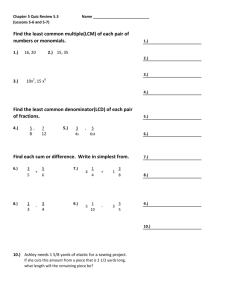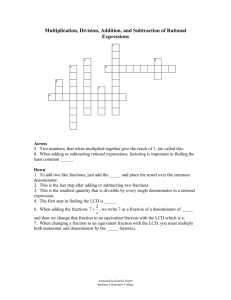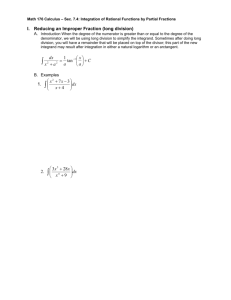1.2 Linear Equations and Rational Equations
advertisement
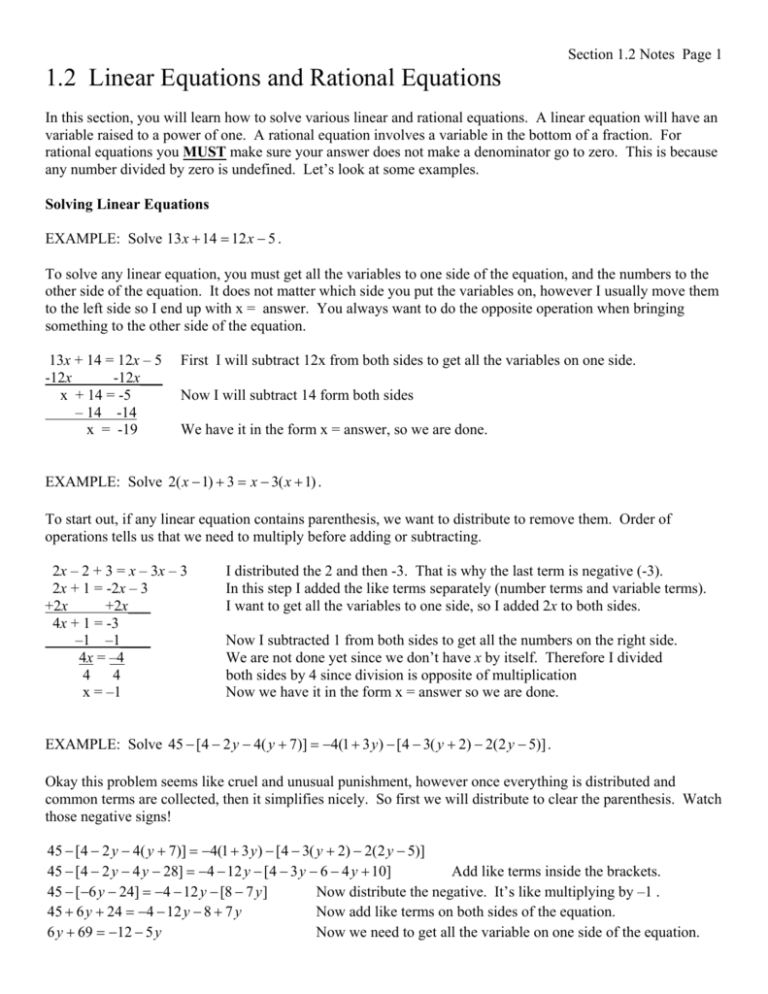
Section 1.2 Notes Page 1 1.2 Linear Equations and Rational Equations In this section, you will learn how to solve various linear and rational equations. A linear equation will have an variable raised to a power of one. A rational equation involves a variable in the bottom of a fraction. For rational equations you MUST make sure your answer does not make a denominator go to zero. This is because any number divided by zero is undefined. Let’s look at some examples. Solving Linear Equations EXAMPLE: Solve 13 x 14 12 x 5 . To solve any linear equation, you must get all the variables to one side of the equation, and the numbers to the other side of the equation. It does not matter which side you put the variables on, however I usually move them to the left side so I end up with x = answer. You always want to do the opposite operation when bringing something to the other side of the equation. 13x + 14 = 12x – 5 -12x -12x___ x + 14 = -5 – 14 -14 x = -19 First I will subtract 12x from both sides to get all the variables on one side. Now I will subtract 14 form both sides We have it in the form x = answer, so we are done. EXAMPLE: Solve 2( x 1) 3 x 3( x 1) . To start out, if any linear equation contains parenthesis, we want to distribute to remove them. Order of operations tells us that we need to multiply before adding or subtracting. 2x – 2 + 3 = x – 3x – 3 2x + 1 = -2x – 3 +2x +2x___ 4x + 1 = -3 –1 –1____ 4x = –4 4 4 x = –1 I distributed the 2 and then -3. That is why the last term is negative (-3). In this step I added the like terms separately (number terms and variable terms). I want to get all the variables to one side, so I added 2x to both sides. Now I subtracted 1 from both sides to get all the numbers on the right side. We are not done yet since we don’t have x by itself. Therefore I divided both sides by 4 since division is opposite of multiplication Now we have it in the form x = answer so we are done. EXAMPLE: Solve 45 [4 2 y 4( y 7)] 4(1 3 y ) [4 3( y 2) 2(2 y 5)] . Okay this problem seems like cruel and unusual punishment, however once everything is distributed and common terms are collected, then it simplifies nicely. So first we will distribute to clear the parenthesis. Watch those negative signs! 45 [4 2 y 4( y 7)] 4(1 3 y ) [4 3( y 2) 2(2 y 5)] 45 [4 2 y 4 y 28] 4 12 y [4 3 y 6 4 y 10] Add like terms inside the brackets. 45 [6 y 24] 4 12 y [8 7 y ] Now distribute the negative. It’s like multiplying by –1 . 45 6 y 24 4 12 y 8 7 y Now add like terms on both sides of the equation. 6 y 69 12 5 y Now we need to get all the variable on one side of the equation. Section 1.2 Notes Page 2 6 y 69 12 5 y +5y +5y 11y + 69 = –12 –69 –69 11y = -81 81 y 11 EXAMPLE: Solve Now divide both sides by 11. Yes fractions are possible answers. x 1 1 2 x . 4 6 3 Even though this may look like a rational equation, it is not since there are no variable in the denominator. This is still considered linear. To solve these kind of problems, we will multiply both sides by the least common denominator (LCD). This will clear out the fractions and make the problem easier to solve. In this problem, first we need to find the smallest number that 3, 4, and 6 evenly divide into. This number is 12. Therefore the LCD is 12. I will multiply both sides of the equation by 12. x 1 1 2 x 12 6 3 4 Here I will multiply both sides by the LCD, which is 12. 12 x 1 12 1 12 2 x 1 4 1 6 1 3 I wrote 12 as a fraction and put it next to each term. 3 x 1 2 1 4 2 x 1 1 1 1 1 3 Next I reduced each fraction before multiplying. 3(x + 1) = 2 + 4(2 – x) Notice that all the fractions are gone, so now solve. 3x + 3 = 2 + 8 – 4x 3x + 3 = 10 – 4x +4x + 4x 7x + 3 = 10 –3 –3 7x = 7 x=1 We have it in the form x = answer so we are done. Solving Rational Equations To solve these, we will do the same as in the previous example. We will multiply both sides by the least common denominator (LCD). This will clear out the fractions and make the problem easier to solve. The following problems contain rational equations with variables in the denominators. For each equation a.) write the value(s) of the variable that make the denominator zero. b.) Keeping the restrictions in mind, solve the equation. Section 1.2 Notes Page 3 EXAMPLE: Solve 5 8 1 1 . 2 x 9 18 3x For part a, zero will cause the denominator to be zero. For part b, first we need to find the LCD. It is the smallest thing that all the denominators evenly divide into. The LCD here would be 18x. 1 5 8 1 18 x 2 x 9 18 3x First multiply both sides of the equation by 18x (LCD). 18 x 5 18 x 8 18 x 1 18 x 1 1 2 x 1 9 1 18 1 3x I wrote 18x as a fraction and put it next to each term. 9 5 2x 8 x 1 6 1 1 1 1 1 1 1 1 1 45 – 16x = x – 6 –x –x___ 45 – 17x = –6 –45 –45 –17x = –51 –17 –17 x=3 EXAMPLE: Solve In this step I reduced the fractions before multiplying. Notice that all the fractions are gone, so now solve. Divide both sides by -17 This does not cause the denominator to be zero so we are done. 3 4 . 7 x4 x4 For part a, -4 will cause the denominator to be zero. For part b, first we need to find the LCD. Here it would be x + 4. I will write 7 as 7/1. 7 4 3 ( x 4) x 4 1 x 4 First multiply both sides of the equation by the LCD. x 4 3 x 47 x 4 4 1 x4 1 1 1 x4 I put the LCD next to each term. 1 3 x 47 1 4 1 1 1 1 1 1 In this step I reduced the fractions before multiplying. 3 – 7(x + 4) = –4 3 – 7x – 28 = –4 – 7x – 25 = –4 +25 +25 – 7x = 21 –7 –7 x = –3 Notice that all the fractions are gone, so now solve. Distribute the -7 to get rid of the parenthesis Divide both sides by -7 This does not cause the denominator to be zero so we are done EXAMPLE: Solve 6 5 20 2 . x3 x2 x x6 Section 1.2 Notes Page 4 For part a, both 3 and -2 will cause the denominator to be zero. For part b, first we need to find the LCD. If any of the denominators can be factored, you want to do that first. The x 2 x 6 can be factored into (x + 3)(x – 2). Now we see that the LCD is (x + 3)(x – 2). I will multiply this on both sides and then reduce each fraction as normal. This will result in no more fractions. 6 5 20 ( x 3)( x 2) x 3 x 2 ( x 3)( x 2) ( x 3)( x 2) 6 ( x 3)( x 2) 5 ( x 3)( x 2) 20 1 x3 1 x2 1 ( x 3)( x 2) ( x 2) 6 ( x 3) 5 1 20 1 1 1 1 1 1 6(x – 2) – 5(x + 3) = –20 6x – 12 – 5x – 15 = –20 x – 27 = –20 +27 +27 x=7 EXAMPLE: Solve Notice how the fractions were reduced here. Distribute the 6 and the -5 to clear parenthesis. Add 27 to both sides of the equation. This does not cause the denominator to be zero so we are done. 5 3 12 2 . x2 x2 x 4 For part a, both 2 and -2 will cause the denominator to be zero. For part b, first we need to find the LCD. So we notice that x 2 4 can be factored into (x + 2)(x – 2). Now we see that the LCD is (x + 2)(x – 2). I will multiply this on both sides and then reduce each fraction as normal. This will result in no more fractions. 5 3 12 ( x 2)( x 2) x 2 x 2 ( x 2)( x 2) ( x 2)( x 2) 5 ( x 2)( x 2) 3 ( x 2)( x 2) 12 1 x2 1 x2 1 ( x 2)( x 2) ( x 2) 5 ( x 2) 3 1 12 1 1 1 1 1 1 5(x – 2) + 3(x + 2) = 12 5x – 10 + 3x + 6 = 12 8x – 4 = 12 8x = 16 x=2 x Notice how the fractions were reduced here. Distribute the 5 and the 3 to clear parenthesis. Add 4 to both sides of the equation Divide both sides by 8. This causes the denominator to be zero, so therefore there is NO SOLUTION! Section 1.2 Notes Page 5 Types of Equations Equations can be classified depending on the final answer. Here are three categories: Identity: An equation is true for all values of x. Conditional Equation: An equation that is not an identity that is true for at least one real number Inconsistent Equation: An equation that is NOT true for any real number. For each example below, solve each equation and classify it as and identity, conditional, or inconsistent. EXAMPLE: – 4(x + 7) = – 4x – 28 –4x – 28 = – 4x – 28 +4x +4x – 28 = – 28 EXAMPLE: I first distributed the 4 on the right side. Add 4x to both sides This is always true for every number, so it is an identity. 6 2x 2 x3 x3 First we need to find the LCD. Here it would be x + 3. I will write 2 as 2/1. 2 2x 6 ( x 3) x 3 1 x 3 First multiply both sides of the equation by the LCD. x 3 6 x 3 2 x 3 2x 1 x3 1 1 1 x3 I put the LCD next to each term. 1 6 x 3 2 1 2x 1 1 1 1 1 1 In this step I reduced the fractions before multiplying. 6 + 2(x + 3) = –2x 6 + 2x + 6 = –2x 2x + 12 = –2x +2x +2x 4x + 12 = 0 –12 –12 4x = –12 4 4 x = -3 x Notice that all the fractions are gone, so now solve. Distribute the 2 to get rid of the parenthesis Divide both sides by -7 The answer makes the denominator in the original problem zero, so this answer cannot be included. Therefore there is NO SOLUTION, therefore this is classified as an inconsistent equation since no real numbers will make it true. In all of my previous examples where there is one solution, these equations would be classified as conditional equations, since the equation holds true for the one single answer.


